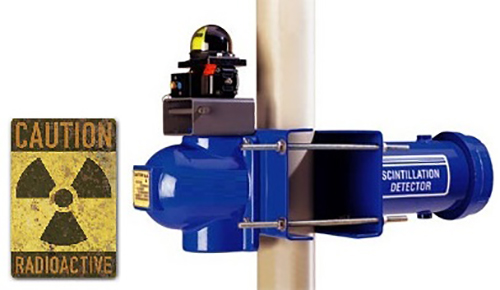Restricting the use of radioactive densitometers as a way to improve safety in mining operations

Figure 1- Typical installation of a nuclear densitometer for mineral processing applications.
Mineral processing plants deal with ores in two basic forms: bulk ore and ore slurry [1,2]. An ore slurry is a mixture of ore particles and water. Information is gathered from the equipment used to process slurries, such as cyclones, filters, thickeners, and froth flotation cells, as far as slurry density for their proper operation and control [1].
Nuclear or radioactive densitometers (See Figure 1) are frequently used to measure the density of ore slurries flowing in pipelines. Some advantages of nuclear densitometers are: non-intrusive and contactless measurement; easy external mounting on pipelines; no need for process operation stoppages during maintenance interventions; and a robust construction. However, they also have drawbacks: the need for permanent, safe care due to the risks of occupational accidents involving ionizing radiation and the need for field calibration using actual ore slurry from the production process, which rarely covers the full operating range, resulting in poorly representative calibrations.
Nuclear densitometers are a mature instrument technology with proven feasibility in several industrial applications. On the other hand, there are also several non-radioactive technologies for liquid density measurement. Certain industries such as chemical, petrochemical and pharmaceutical have been successful in using non-radioactive densitometers, which are not yet common in the mineral processing industry, due to a lack of knowledge about how to appropriately apply them, as well as due to the harsh industrial conditions of the mineral processing environment.
At Vale, a large global producer of iron ore, nickel and copper ore, radioactive densitometers have historically been used in the processing of ore slurries. However, an effort to replace such densitometers by non-radioactive alternatives was initiated in 2010 by the Southeastern Ferrous Department. Initially a survey on the existing radioactive densitometers was carried out, and feasibility studies to replace radioactive densitometers by non-radioactive alternatives were developed. The first replacements were done in 2011 using differential pressure densitometers [12]. In the following years, other models of non-radioactive densitometers such as vibrating fork [13,14], microwave [15], and ultrasonic [16] were tested for feasibility to operate with iron ore slurries. Not all of them were proven suitable, and some suffered from fast wear caused by slurry abrasion. In 2014, the Executive Ferrous Operations Department requested the elimination of radioactive densitometers from all VALE’s iron ore operations in Brazil, based on the cases of success attained by the Southeastern Ferrous Department.









